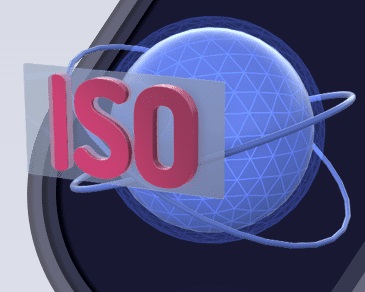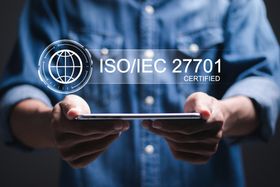ISO 27001 for Startups: An Essential Guide to Certification
Explore ISO 27001 for startups with this essential guide to certification. Learn how to prepare, budget, document, and maintain compliance, plus how GRSee Consulting supports you every step of the way.
Published May 25, 2025.

Getting ISO 27001 certified can feel overwhelming for startups without dedicated compliance or IT security teams. However, investors, enterprise customers, and partners increasingly expect this certification as proof that your startup properly protects sensitive data. For startups, achieving ISO 27001 certification is not just about meeting requirements, it’s about building trust early and establishing a strong foundation for secure and reliable operations. The good news is that ISO 27001 compliance for startups is possible with the right strategy, even on a lean budget. By focusing on what matters most, assigning clear responsibilities, and using smart tools, your startup can move toward certification with confidence and control.
In this blog, we’ll walk through how your startup can become ISO 27001 compliant step by step, from understanding what’s needed to get started, to building the right documentation, preparing for audits, and applying best practices that help you stay compliant as your business grows.
» Ready to become ISO 27001 compliant? Find out how GRSee can help
A Quick Overview: What Is ISO 27001?
ISO 27001 is an international standard for managing information security. It outlines requirements for establishing, implementing, maintaining, and continually improving an Information Security Management System (ISMS). The goal is to protect sensitive data through risk management and security controls.
» Make sure you understand the importance and key principles of ISO 27001
Short-Term Benefits of ISO 27001 Certification for Startups
- Rapid increase in customer trust and deal velocity: ISO 27001 certification immediately signals to clients and partners that the startup takes data protection seriously, building trust and credibility from day one. This is especially valuable when targeting enterprise clients or regulated industries, where security is a prerequisite.
- Competitive differentiation and market access: Certification sets startups apart from competitors lacking formal security credentials, opening doors to new business opportunities and markets, especially those requiring strict compliance. Many large corporations and government agencies mandate ISO 27001 for vendors, so that startups can unlock contracts and partnerships otherwise out of reach. Case studies show certified startups are more likely to win enterprise deals and international clients.
- Streamlined operations and cost avoidance: Adopting ISO 27001 introduces standardized processes, clear documentation, and defined roles, reducing confusion and operational errors. This structure helps prevent costly data breaches and compliance failures, which can be devastating for young companies. Startups benefit from immediate cost savings by avoiding corrective actions and focusing resources on growth rather than crisis management.
» Learn why you need to be ISO 27001 certified
Long-Term Benefits of ISO 27001 Certification for Startups
- Sustained customer loyalty and brand reputation: Maintaining ISO 27001 certification demonstrates an ongoing commitment to security, fostering lasting customer relationships, and a reputation for reliability. This trust translates to higher retention rates, positive referrals, and resilience in the face of security incidents, as clients are reassured by the startup’s proactive risk management.
- Enhanced operational resilience and risk management: ISO 27001 requires continuous improvement of security controls, incident response planning, and regular risk assessments. Over time, this builds a culture of security awareness and operational resilience, enabling startups to adapt to evolving threats and regulatory changes. Certified startups experience fewer and less severe security incidents, supporting uninterrupted business growth.
- Improved investor confidence and business valuation: Investors increasingly scrutinize cybersecurity posture as part of due diligence. ISO 27001 certification signals maturity and reduces perceived risk, making startups more attractive investment targets. Certified startups often see higher valuations and smoother funding rounds, as investors are assured that future resources won’t be drained by preventable security lapses.
- Scalable compliance and global expansion: The ISO 27001 framework aligns with many international regulations, making it easier for startups to enter new markets and comply with evolving legal requirements. This scalability supports sustainable growth and positions startups for long-term success in a globalized economy.
» Make sure you understand what good compliance is, and how to get started
Startup Cybersecurity Risks
Startups operate in high-speed environments with fewer resources, making them more exposed to certain cyber risks than their more established counterparts.
Below are five common vulnerabilities that frequently affect startups more than mature companies.
1. Inadequate Security Controls
Startups often delay implementing robust security controls, believing they are “too small” to be targeted or that cybersecurity can wait until after growth milestones. This leaves them exposed to basic attacks such as credential stuffing, phishing, or exploitation of default configurations that mature firms have already mitigated. Limited budgets and a lack of in-house expertise further compound this risk, making it easy for attackers to exploit simple weaknesses.
2. Ransomware and Endpoint Vulnerabilities
The fast-paced, agile culture of startups, combined with widespread adoption of remote work, leads to inconsistent endpoint security and a larger attack surface. Every day, tools like desktop sharing software and unsecured emails are frequently exploited, and startups rarely have the resources or experience to respond effectively to ransomware incidents. Nearly 80% of reported cyberattacks on very small businesses are ransomware-related, with 40% linked to insecure remote access tools.
3. DDoS Attacks and Infrastructure Fragility
Startups often launch with minimal, untested infrastructure that lacks DDoS protection or redundancy. Even moderate DDoS attacks can take down their websites, APIs, or apps, resulting in lost revenue and damaged customer trust. Mature companies typically have dedicated teams and established processes to mitigate such attacks, while startups may lack both the awareness and resources to prepare for them.
4. Community Trust Erosion
Startups dependent on user communities (e.g., marketplaces, social platforms) are particularly vulnerable to spam, fake profiles, and fraudulent transactions. With limited resources for identity verification and fraud detection, attackers can quickly undermine user trust—something that is far more difficult for a startup to recover from than a well-established brand.
5. Supply Chain and Third-Party Risk
Hackers often target startups as stepping stones to larger organizations, exploiting their weaker security to access partner or client networks. Startups serving enterprise or government clients are especially at risk if they lack rigorous vendor risk management and secure integration practices, making them attractive entry points for sophisticated attackers.
» Check out these cyber tips for your startup plan
Step-by-Step: ISO 27001 Compliance for Startups
Stage 1: Preparation and Initial Assessment
Begin by securing leadership commitment and forming a small ISO 27001 project team, including a project lead and key stakeholders from IT and operations. Conduct a candid assessment of your current security posture, policies, and controls to identify strengths and gaps. Familiarize the team with ISO 27001 requirements through training or workshops.
| Common Challenge | Solution |
|---|---|
| Startups often struggle with limited resources and competing priorities. | Avoid underestimating the time required for assessment and planning. Ensure leadership understands the business value of certification to secure buy-in and resources. |
Resources/Roles/Documentation:
- ISO 27001 standard documentation
- Leadership endorsement
- Project charter and initial gap analysis report
- Assignment of roles (e.g., project manager, security officer)
Tip: Use free or low-cost ISO 27001 checklists and online guides to streamline the initial assessment for lean teams.
Stage 2: Define ISMS Scope and Conduct Risk Assessment
Clearly define the scope of your Information Security Management System, what business units, assets, and processes are included. Identify and catalog information assets, then perform a formal risk assessment to evaluate threats, vulnerabilities, and potential impacts.
| Common Challenge | Solution |
|---|---|
| Startups may find it difficult to balance comprehensive coverage with practical focus. | Avoid scoping too broadly, which can overburden lean teams, or too narrowly, which may miss critical risks. |
Resources/Roles/Documentation:
- Asset inventory
- Scope statement
- Risk assessment methodology and results
- Risk register
Tip: Leverage simple asset inventory templates and risk assessment tools to accelerate this process without sacrificing thoroughness.
» Here are 6 things you should know before hiring a risk assessment provider
Stage 3: Develop Policies, Controls, and Risk Treatment Plan
Draft and formalize information security policies and procedures tailored to your startup’s context. Select and implement security controls from ISO 27001 based on your risk assessment, and document a risk treatment plan outlining how each risk will be managed.
| Common Challenge | Solution |
|---|---|
| Startups often lack formal documentation or may overcomplicate controls. | Focus on clarity and relevance, policies should be easy for all staff to understand and follow. Prioritize controls that address your highest risks and regulatory obligations. |
Resources/Roles/Documentation:
- Information security policy
- Risk treatment plan
- Control implementation records
- Policy and procedure documents
Tip: Customize sample policy templates and only implement controls that are justified by your risk assessment to avoid unnecessary complexity.
Stage 4: Training, Awareness, and ISMS Operation
Roll out security awareness training for all employees, emphasizing their specific responsibilities under the ISMS. Begin operating the ISMS: enforce policies, monitor controls, and maintain security logs and records. Establish mechanisms for incident reporting and response.
| Common Challenge | Solution |
|---|---|
| Startups may overlook the importance of ongoing awareness, leading to policy violations or weak adoption. | Make training practical, concise, and role-specific to maximize engagement. |
Resources/Roles/Documentation:
- Training materials and attendance records
- Incident response procedures
- Operational logs and evidence of control effectiveness
Tip: Integrate security training into onboarding and use short, regular refreshers to keep awareness high without disrupting productivity.
Stage 5: Internal Audit, Management Review, and Continuous Improvement
Conduct an internal audit to evaluate ISMS effectiveness and identify gaps. Present findings to management for review and implement corrective actions. Prepare for the external certification audit by ensuring all documentation and evidence are up to date and accessible.
| Common Challenge | Solution |
|---|---|
| Startups may lack internal audit expertise. | Consider using external consultants or automated compliance tools to streamline the process. |
Resources/Roles/Documentation:
- Internal audit reports
- Management review minutes
- Corrective action logs
- Complete ISMS documentation set
Tip: Schedule regular (e.g., quarterly) mini-audits and management reviews to catch issues early and foster a culture of continuous improvement.
Stage 6: Certification Audit and Ongoing Maintenance
Engage an accredited certification body to conduct the external audit. Address any findings promptly. Once certified, maintain compliance through regular reviews, periodic risk assessments, ongoing training, and continual ISMS improvement.
| Common Challenge | Solution |
|---|---|
| Startups may underestimate the effort required for ongoing maintenance. | Avoid complacency post-certification, ISO 27001 requires continual vigilance. |
Resources/Roles/Documentation:
- Certification audit reports
- Evidence of ongoing ISMS activities
- Updated risk assessments and training records
Tip: Automate evidence collection and compliance monitoring where possible to reduce manual effort and ensure you remain audit-ready year-round.
» Need more guidance? Check out this guide on how to become ISO 27001 compliant
Tips for Handling ISO 27001 Documentation Without Dedicated Compliance Teams
1. Use Simple, Modular Templates
Startups without dedicated compliance teams should avoid overcomplicating documentation. Use straightforward, modular templates for essential policies such as information security, access control, and incident response—tailored to your actual processes and risks. Prioritize clarity and relevance over volume: it’s better to have a few well-maintained, practical documents than dozens of generic ones. This approach reduces maintenance overhead and ensures documentation remains actionable and accessible to all staff.
2. Assign Documentation Ownership
Rather than relying on a separate compliance function, assign documentation responsibilities to existing team members who are closest to relevant processes (e.g., product lead for access control, operations for incident response). Make documentation updates part of routine workflows, such as change management or onboarding, so policies and records evolve naturally as the business grows. This distributed model fosters shared accountability and keeps documentation current without extra headcount.
3. Centralize Docs in the Cloud
Store all ISO 27001 documents in a secure, centralized cloud repository with clear folder structures and access controls. This ensures everyone can find the latest versions, supports remote or distributed teams, and simplifies evidence collection for audits. Tools like Google Drive, Notion, or dedicated GRC platforms can provide version history and collaboration features, making it easier to manage updates and demonstrate compliance even with limited resources.
» Did you know? The cloud might not be safe anymore
ISO 27001 Costs for Startups and Budget Planning
ISO 27001 certification costs for startups usually range from $10,000 to $50,000, depending on company size, ISMS complexity, current security maturity, and choice of internal teams, consultants, or automation tools.
Internal costs include staff time, productivity loss, and training.
External costs cover gap analyses ($5,000–$7,500), penetration tests ($2,000–$20,000), and certification audits ($5,000–$50,000). Ongoing surveillance audits add $5,000–$40,000 every 1-2 years.
To Budget Effectively, Startups Should:
- Map out all phases: preparation, implementation, audit, and annual maintenance.
- Consider lower-cost options like compliance automation ($8,000–$10,000) or GRC tools ($7,500) to streamline documentation and reduce manual effort.
- Allocate funds for essential tools, training, and potential productivity impacts.
- Obtain quotes from multiple auditors and consultants to find the best fit for your scale and needs.
» Learn more about the best practices for ISO 27001 penetration testing
Indicators a Startup Is Ready for ISO 27001
Leadership commitment and resource allocation
- A startup is ready when leadership actively supports information security, understands the value of ISO 27001, and commits sufficient resources—budget, personnel, and time.
- Embedding a security culture and involving decision-makers in risk management and policy development is crucial. Without this, certification efforts often stall or fail.
Comprehensive asset and data inventory
- Readiness shows in having a clear, current inventory of all information assets—cloud services, internal tools, customer data, and third-party integrations.
- Knowing what needs protection, where it resides, and who manages it is essential for defining scope, assessing risks, and applying controls.
Documented policies, procedures, and controls
- Being prepared means having documented, communicated security policies, procedures, and controls aligned with ISO 27001, covering access control, incident response, and business continuity.
- Up-to-date and relevant documentation prevents common certification hurdles.
Completed gap analysis and internal audit
- True readiness includes finishing a detailed gap analysis against ISO 27001 and conducting internal audits to evaluate control effectiveness.
- Fixing weaknesses and documenting corrective actions reduces surprises during the official certification audit.
Best Practices for Maintaining ISO 27001 Compliance During Growth
- Schedule regular internal and surveillance audits: Startups should proactively plan and conduct internal audits ahead of annual surveillance audits to continuously verify ISMS effectiveness. This ensures early identification and remediation of compliance gaps, reducing last-minute surprises during external audits. Assign knowledgeable, independent team members or engage third-party auditors to maintain objectivity. Scheduling audits in advance helps coordinate resources and keeps the compliance process smooth despite rapid growth or changes.
- Perform frequent security reviews: Conduct regular security reviews, including access control checks, vulnerability scans, and incident response tests, to identify emerging risks from product changes or team scaling. Update risk assessments periodically to reflect evolving threats and business operations. Maintaining an accurate asset inventory, including any unofficial or unmanaged IT resources (shadow IT), helps support security reviews and reduces the risk of compliance gaps as your startup grows and changes rapidly.
- Conduct management reviews: Hold management reviews at least bi-annually to evaluate ISMS performance, audit results, risk management effectiveness, and alignment with business objectives. This executive oversight enables timely decisions on necessary ISMS updates or resource allocation.
- Foster continuous improvement: Embedding continuous improvement practices ensures the ISMS evolves alongside the startup’s growth, maintaining compliance and operational resilience.
Take Note: ISO 27001 audits follow a structured schedule: After the initial certification audit, organizations undergo annual surveillance audits in years one and two, followed by a comprehensive recertification audit every three years. Internal audits are also required at least annually to ensure ongoing compliance and continuous improvement.
» Find the right framework for your business: NIST vs. ISO 27001
How GRSee Simplifies ISO 27001 for Startups
If your startup is aiming for ISO 27001, the path forward doesn’t have to be complex or time-consuming. At GRSee Consulting, we specialize in helping early-stage companies achieve certification by managing the process from beginning to end. We start with a tailored gap analysis to identify what’s already working and what needs improvement, then build a clear work plan that fits your product, team, and scale.
You don’t need to become security experts overnight; we guide you through readiness and pre-audit phases, represent you during the actual audit, and help you get certified quickly the first time. Our hands-on approach is designed to reduce the load on your team, simplify complex requirements, and avoid unnecessary delays. With a 100% audit success rate and deep experience supporting startups, we ensure your ISO 27001 certification journey stays on track from start to finish.
» Ready to begin? Contact us to start your ISO 27001 compliance process





